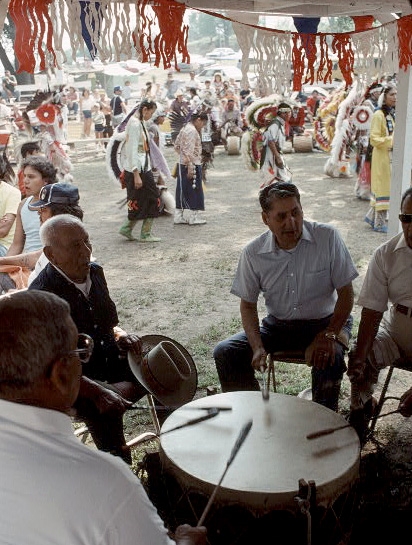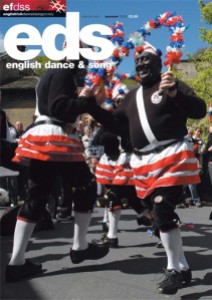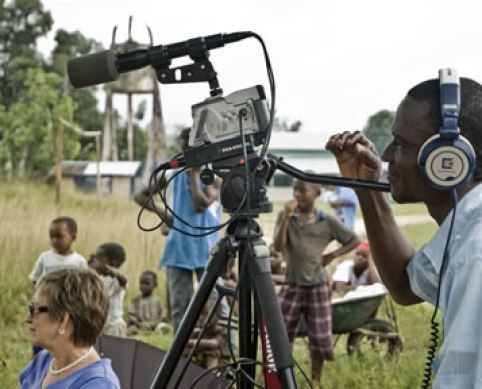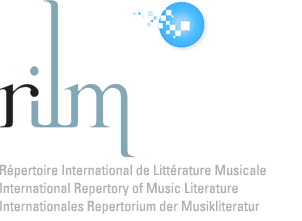Part of the online American memory series sponsored by the Library of Congress, Omaha Indian music presents traditional Omaha music recorded in Nebraska in the 1890s and 1980s. This multiformat ethnographic field collection comprises 44 wax cylinder recordings collected between 1895 and 1897 by Francis La Flesche and Alice Cunningham Fletcher, 323 songs and speeches from the 1983 Omaha powwow (above), and 25 songs and speeches from a 1985 concert at the Library of Congress; contextual information is provided by photographs, field notes, and interviews with Omaha tribe members.
Category Archives: Ethnomusicology
Omaha Indian music
Comments Off on Omaha Indian music
Filed under Ethnomusicology, North America, Resources
Follow the drinking gourd
In 2008 the technology and publishing executive Joel Bresler created the multimedia website Follow the drinking gourd to share his research into the origins and history of the U.S. song, which was popularized by The Weavers and has been recorded some 200 times and reprinted in over 75 songbooks.
While providing ample documentation of the song’s reception history, this unusual resource probes persistent questions regarding the song’s provenance—not least, whether there is any basis for the idea that it was sung by African Americans during the Underground Railroad era. The site presents discussions by authoritative folklorists exploring such questions, and concludes with an invitation to collaborate by supplying further documentation.
Above, the first known publication of the song (Austin: Texas Folklore Society, 1928).
Comments Off on Follow the drinking gourd
Filed under Ethnomusicology, North America, Reception, Resources, Source studies
Rāgs and recipes
In “Why Hindustani musicians are good cooks: Analogies between music and food in North India” (Asian music XXV/1–2 (1993–94), pp. 69–80), Adrian McNeil notes that culinary topics are frequent—sometimes even favorite—subjects of conversation among Hindustani musicians, and that a notable number of top Indian musicians are also expert cooks. He attributes this phenomenon to the similarities between the cognitive and sensory aspects of the two activities, and proposes a “culinary perspective” on rāg.
Offering a basic “culinary recipe” alongside a basic “melodic recipe”, McNeil similarly juxtaposes, in a two-page spread, a photographic “depiction of potato with ginger and puris” with a rāgamālā “depiction of rāg sārant”. Further positing a “melodic conception of food”, he recounts examples of Indian musicians using culinary analogies to illustrate musical matters, and cites a use of the phrase biryāni chicken khā (eat chicken biryāni) to convey a rhythmic pattern to a hungry mrdangam player.
Comments Off on Rāgs and recipes
Filed under Asia, Curiosities, Ethnomusicology, Food, Theory, World music
English dance & song
Published by the English Folk Dance and Song Society, English dance & song has appeared at least four times a year since it was launched in 1936. The magazine presents festival listings and other news, interviews with current English traditional and neotraditional performers, and reviews of current publications, as well as brief research-based articles that explore historical documents and current practices.
The Society, which was formed in 1932 by the merger of the Folk-Song Society (founded in 1898) and the English Folk Dance Society (founded in 1911), also publishes a scholarly periodical, Folk music journal.
Related articles:
Comments Off on English dance & song
Filed under Dance, Europe, Music magazines, World music
Association for Cultural Equity
Founded by Alan Lomax in 1983, The Association for Cultural Equity‘s mission—“to facilitate cultural equity, the right of every culture to express and develop its distinctive heritage”—is realized through several projects that use and expand upon Lomax’s research, including the digitization and dissemination of his field collections.
As a part of this service, ACE supports a free online research center that includes an archive of Lomax’s collections; the sound recordings are indexed by place in ACE’s Lomax Geo-Archive, which provides excerpts from the recordings along with the full details of each recording session. Through cooperation with ACE, the American Folklife Center houses Lomax’s physical collection.
Comments Off on Association for Cultural Equity
Filed under Ethnomusicology, Resources, World music
EVIA Digital Archive Project
The EVIA Digital Archive Project is a collaborative peer-reviewed digital archive of ethnographic field videos for use by scholars and teachers; it is also an infrastructure of tools and systems supporting scholars in the ethnographic disciplines, including ethnomusicology and ethnochoreology.
Since its founding in 2001, the project has been developed through the joint efforts of ethnographic scholars, archivists, librarians, technologists, and legal experts, with funding from the Andrew W. Mellon Foundation, Indiana University, and the University of Michigan. There is no charge for access for educational purposes. Above, the videographer James B. Weegi assists the ethnomusicologist Ruth M. Stone with materials that are now part of her EVIA collection.
Comments Off on EVIA Digital Archive Project
Filed under Africa, Ethnomusicology, Resources, World music
Program notes
Like souvenir books, program notes may be considered ephemera, but often they are the best sources for information about important productions, festivals, and other events. Some, like Playbill, are issued as numbered periodicals that libraries and individuals subscribe to. Others include original essays by distinguished scholars—for example, the program book for the Smithsonian Institution’s 1997 Festival of American Folklife (above) included articles by the ethnomusicologists Angela Impey, Joyce Marie Jackson, and Jeff Todd Titon.
Related Articles
- You: Smithsonian Folklife Festival shines spotlight on Haitian art and culture (washingtonpost.com)
Comments Off on Program notes
Filed under North America, Publication types, World music
Blues magazines
Blues magazines like Living blues, Real blues, and Blues revue attest to the continuing vitality of a genre that dates at least back to the 1910s, when the first blues songs were published. Unlike the recording companies that capitalized on the “blues craze” of the Roaring Twenties, these magazines are interested in all forms of African American roots music—including sacred and other secular traditions—and their modern counterparts, including zydeco, gospel, and so on, fostering a thriving community of enthusiasts.
Comments Off on Blues magazines
Filed under Ethnomusicology, Jazz and blues, Music magazines











